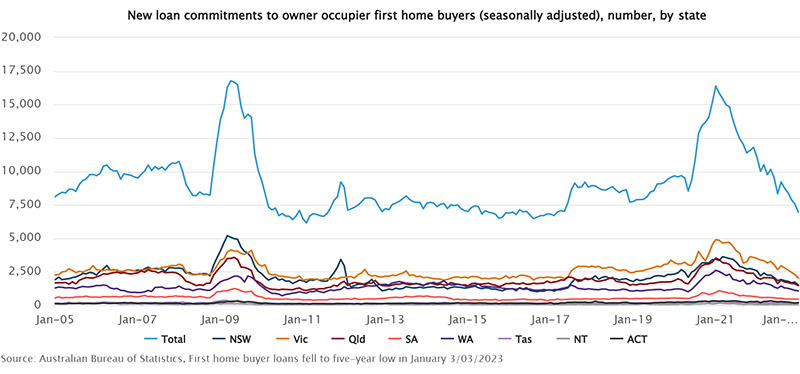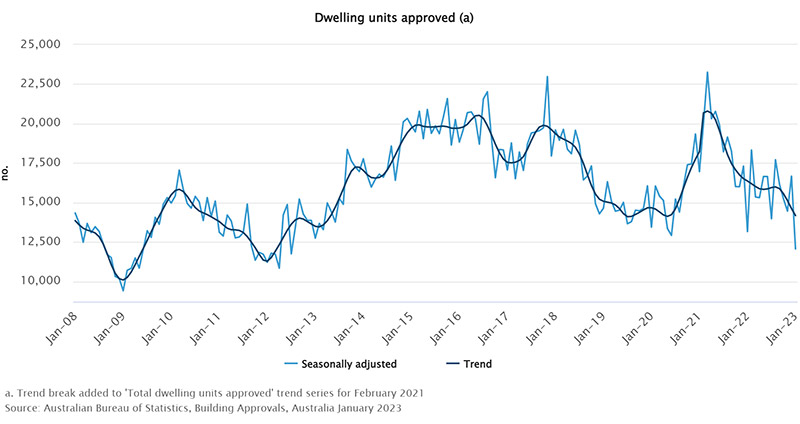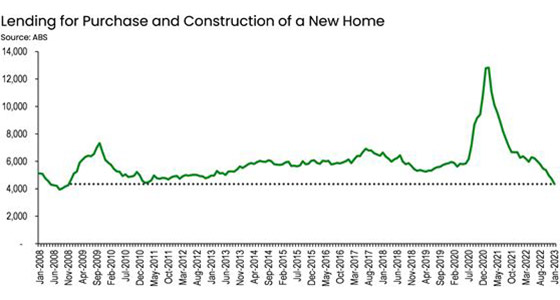Housing crisis unfolds as building approvals, home loan lending collapse
From the building industry to renters and first home buyers, historic lows for building approvals and home loan lending are wreaking havoc across the country.
The building industry that was hit so hard in 2022 is faring no better in 2023, with a raft of numbers painting a bleak picture for the sector and having a contagion effect throughout society.
Building approvals for houses have hit a ten-year low, new owner-occupier first home buyer loan commitments are at a six-year ebb, new housing loan commitments slumped another 5.3 per cent in January and is now 35.0 per cent lower than a year ago.
Beyond the numbers lie a string of casualties awaiting to fall like dominoes as the Reserve Bank of Australia continues its relentless fight against inflation by continually raising interest rates.
As the supply of new housing dries up and first home buyers steer clear of the higher loan commitments, builders are struggling to survive and renters are being hammered by dire vacancy rates and rapidly rising rents.
Rent prices have increased further in January from an annual rise of 4.1 per cent in December to 4.8 per cent in January, reflecting low vacancy rates and a tight labour market.
Households already stretched by inflation at 7.8 per cent are reining in their spending to cope with higher interest rates.
Property prices that have been falling nationally until this month’s minor uptick are also casting many young property owners who bought in the past year or two into the dangerous territory of negative equity.

The numbers are becoming numbing for so many stakeholders.
In just January alone, the total number of dwellings approved fell 27.6 per cent, according to data released Thursday (2 March) by the Australian Bureau of Statistics (ABS).
A day later the news was just as unforgiving.
The number of first home buyer loan commitments fell 8.1 per cent in the same month, while new investor loan commitments fell 6.0 per cent to $7.4 billion.
Approvals for private sector houses fell by 13.8 per cent, the fifth consecutive drop, to be the lowest result recorded since June 2012. Attached dwelling approvals dived, falling 40.8 per cent. With the exception of Queensland (+25.6 per cent) where some major apartment projects provided support, all states were in the red, with New South Wales (-49 per cent) seeing the biggest monthly fall.
In Western Australia, home approvals plunged to a 40-year low as interest rates and debilitating blowouts in construction times and critical housing supply shortages deterred buyers from new builds.

Dr Timothy O’Leary, Senior Lecturer in Construction Economics, University of Melbourne, told API Magazine that the slowdown in the pipeline inevitably leads to more builders folding.
“It can be difficult to forecast conditions more than a few quarters into the future, however, the ABS data on approvals is a key indicator and the signs of a slowdown are there.
“National forecasts are more accurate than forecasts for individual states but it does appear Queensland is suffering more failures of home builders over and above other states at present,” he said.
Signs of some moderation in the cost of building materials and an easing of labour shortages as unemployment has risen had offered glimmers of hope but even those have seemingly faded.
“Some moderation of above-trend building material price increases that were due to supply chain issues during the pandemic are evident but the prediction is still for material costs to increase in line with the prevailing level of general inflation in the economy,” Dr O’Leary said.
“The experts in cost forecasting such as Rawlinson’s are predicting that tender prices overall will increase by as much as 5 to 6 per cent over the course of 2023.
Beyond the actual numbers of likely new builds in the ABS approvals data, it is the inability of builders in this country to pass on rising costs that leads to company failures.
“Banks tend to refuse to lend to new home buyers against a cost-plus contract unless the buyer bears the risk, so construction contracts are being re-written with more provision for price escalation clauses, though some states restrict the operation of these clause in lower value building contracts.”
Victoria and Western Australia don’t allow so-called rise and fall clauses in fixed-price contracts for home-building work worth less than $500,000.
Rates point to more pain ahead
Maree Kilroy, Senior Economist for BIS Oxford Economics, said recent messaging from the RBA points to further interest rate hikes in coming months that will likely push the cash rate above 4 per cent, which will weigh further on demand for new dwellings.
Her outlook for the rest of 2023 was not encouraging.
“The near-term outlook for residential building has continued to worsen over recent months and while there are signs that labour and material supply issues are fading in some areas and that construction cost growth has slowed for houses, both of these challenges will persist for builders over 2023 given how big the backlog of work has become.”
Ms Kilroy added that enquiries for greenfield land and off-the-plan apartments are down sharply on a year ago and are set to remain weak over the year ahead, spelling bad news for builders, first home buyers and renters all depleted of new housing stock.
One of the Labor Government’s first major policy announcements upon winning office was the national Housing Accord that aspires to build one million new, well-located homes over five years.
The current environment suggests this ambitious target could be out of reach.
Master Builders Australia CEO Denita Wawn there is increasing concern around meeting Australia’s housing and infrastructure needs given new home building approval have plummeted to a ten-year nadir.
“Despite the intention from governments and industry to reach a target of one million homes under the Housing Accord, the latest data highlights that more needs to be done to tackle supply barriers and to speed up the delivery of new homes and attract investment.
“Without sensible fiscal levers being pulled, we are seeing the negative consequences of rising interest rates playing out,” said Ms Wawn.
Should the government step in?
As industry figures queued to bemoan the latest batch of difficult-to-digest numbers, Real Estate Institute of Australia (REIA) President, Hayden Groves appealed to the RBA to stop lifting interest rates.
“The pipeline for Australia’s housing supply and affordability is looking dire and we need action now,” he said.
“The latest figures overall point to a severe lack of supply and reduced lending capability due to aggressive interest rate hikes contributing to the problem.”

Asked when buyers might return to the new build market, Dr O’Leary said government intervention may be required.
“New home buyers are a key demand driver for new housing construction.
“The resumption of net inward migration, after several years of stalled arrivals, is also a factor in demand for new homes.
“Perhaps some stimulus in the Federal Budget might address this decline.
“As at 7 March 2022, $2.1 billion in grant payments have been made under the Federal HomeBuilder program, however, the scheme has ended as part of the end of pandemic stimulus to the housing industry and so consumers are no longer able to tap into incentives to build or renovate.”
The Urban Development Institute of Australia (UDIA WA) on Friday also reaffirmed support for the introduction of the building stimulus measures at the start of the COVID-19 pandemic.
“We understand that there are many new home buyers that are experiencing prolonged delays and costs associated with the current material and skills shortages impacting on the home building industry and this is really difficult,” UDIA WA CEO Tanya Steinbeck said.





















